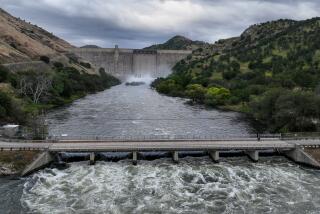Volunteers Watch Over Waterways
- Share via
HARRISBURG, Pa. — They wade into cold streams with color-wheel gauges to test phosphate, nitrate and sulfate levels. They scoop sediment from stream beds, noting its color and smell.
Citizen scientists, they call themselves, volunteers who keep watch over Pennsylvania’s waterways. Men like Jim Haney, a 67-year-old retired environmental engineer from New Cumberland, and Bud Bankert, a 73-year-old retired biology teacher.
About 1,000 senior citizens have enlisted in Pennsylvania’s Senior Environment Corps, a volunteer program launched in 1997 through an agreement between the state departments of aging and environmental protection and a Virginia-based nonprofit organization. And the number of volunteers has grown steadily.
Monitoring work is performed by 21 corps groups covering 42 of the state’s 67 counties. Their gauges measure conductivity, alkalinity and acidity.
The data are entered into an Internet database for use by state environmental officials and members of watershed associations or county conservation districts, or anyone else interested in the health of their local streams or creeks.
In the spring and fall, the volunteers conduct macroinvertebrate inventories, using nets to catch aquatic bugs. They also examine stream banks for erosion and, if they find anything unusual, report it immediately to the state Department of Environmental Protection.
“It’s not just going out and picking a nice shady spot by a stream,” Haney said. “We know a certain spot is important to DEP. Maybe there’s a pipe upstream and there’s effluent that they’re concerned about.”
The volunteer bug bit Bankert three years ago when he saw an advertisement in a York newspaper seeking senior citizens to participate in a water quality monitoring project. Bankert called his fishing buddy Ernie Lauer, a retired Harley-Davidson engineer.
Ever since, the men have been dedicated members of the group.
“We decided it would be a good thing to be involved with, mainly because most people don’t realize how critical the water situation is becoming,” Bankert said. “The only way we can ensure we have good water in the future is to keep monitoring it.”
The volunteer program has become a model for similar efforts in about 15 other states, including California, Oklahoma and New Hampshire, said Tom Benjamin, president of the Environmental Alliance for Senior Involvement, the nonprofit group that administers the program.
The program is funded with about $300,000 in state grants, combined with federal and private grants. State officials say it illustrates how teamwork between individuals and government can benefit the environment. Most of the money is used to train volunteers and provide them with test kits and other light equipment needed to do their sampling.
In Cumberland County, volunteers once found that the stream they had gone to check had disappeared--into a sinkhole caused by construction. They alerted environmental officials and the problem was corrected.
In Philadelphia, a group working on a bacterial monitoring project in Wissahickon Creek is helping determine whether the water is safe for swimming.
“It’s a huge database of information that we wouldn’t have otherwise,” said Diane Wilson, coordinator of the environmental department’s volunteer monitoring programs. “These people are on reaches of streams where nobody else goes.”
David Hess, environmental department secretary, regards the corps as a kind of health insurance policy for state waterways.
“Having 1,000 extra pairs of eyes is invaluable,” he said.
“There are 83,000 miles of waterways in Pennsylvania, and are we hitting them all? No,” said Beth Grove of the Environmental Alliance. “But we’re making one heck of a dent in them.”
More to Read
Sign up for Essential California
The most important California stories and recommendations in your inbox every morning.
You may occasionally receive promotional content from the Los Angeles Times.













